Oda Nobunaga, the Warrior Fool
Nobunaga was born the heir to the Oda clan in 1534. He was his father Nobuhide’s second son, but his elder brother Nobuhiro was illegitimate. The clan had historically been the vassals of a more powerful clan, the Shiba, but eighty years earlier they had declared their independence (though they still owed the Shiba nominal fealty) and taken over most of the small province of Owari as their lands. Nobuhide sought to solidify that dominion and take the whole province, though he never quite succeeded in that. His great rival was Saito Dosan, the lord (”daimyo”) of Mino Province to the north. [1] In 1547 Dosan defeated Nobuhide in battle, and as a result of this Nobuhide was forced to marry Nobunaga to Dosan’s daughter Nohime to seal a peace treaty. On paper this was a very advantageous marriage for Nohime, but in practice she may have regretted he father’s choice. Her new husband had by that time gained infamy as “the great fool of Owari province”.
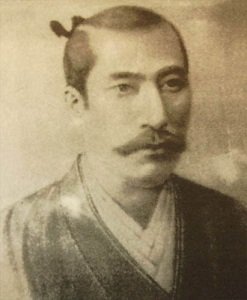
Nobunaga’s reputation for foolishness appears to have come from two sources. The first was his lack of respect for tradition, something that would actually serve him well later in life. The second was his dislike of his father, which drove him to act outrageously. Nobuhide had clearly preferred his eldest son Nobuhiro, but as an illegitimate son couldn’t inherit he was forced to declare Nobunaga his heir. For his part Nobunaga may have resented the marriage to Nohime, though at their wedding he spoke highly of her. Nobuhide died in 1551, his ambition to cement his control of Owari unfulfilled. At his funeral Nobunaga made his opinion of his father abundantly clear, throwing incense at the altar in disrespect. This was such a scandal that it reportedly drove his mentor, Hirate Masahide, to commit seppuku out of shame. It also convinced many of the Oda clan’s retainers and vassals that there was no future for the clan with Nobunaga in charge. Little did they know how wrong they were.
Two main rivals to Nobunaga’s claim to leadership soon rose up. Nowhere near as foolish as his reputation painted him, Nobunaga knew that his life depended on eliminating hem both. The first was his younger brother Nobuyuki, who many of the Oda clan’s retainers preferred to him. Nobuyuki was reportedly very soft-spoken and respectful, unlike his abrasive elder sibling. The other main rival was Nobunaga’s uncle Nobutomo, who was the head of a splinter branch of the Oda clan. Nobutomo took advantage of the fact that the Oda clan were still technically subservient to the Shiba clan by dominating that clan’s head, Yoshimune, and forcing him to confirm his leadership. However Yoshimune resented this and passed on details of Nobutomo’ plans to Nobunaga. When Nobutomo learned of this he had Yoshimune killed, leaving his young son Yoshikane as heir. This action helped to gain Nobunaga support, and with the aid of another of his uncles, Nobumitsu, he killed Nobutomo and gained control of Yoshikane. He then proposed an alliance to the other vassals of the Shiba (the Imagawa and the Kira clans). With no real excuse to decline, the two agreed to ally with him. All of a sudden the Fool of Owari Province was now its most powerful leader.
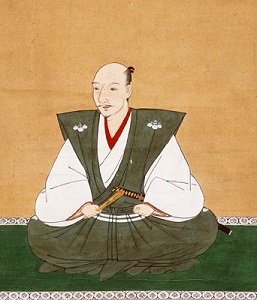
Nobuyuki remained a thorn in his brother’s side, however. When Nobunaga led his forces out of the province to assist his father-in-law Saito Dosan [2], Nobuyuki took his chance to rebel. Nobunaga defeated him, but at his mother’s request pardoned the leaders of the rebellion. The two commanders of Nobuyuki’s force were astounded at his clemency, and one (Shibata Katsuie) went on to be one of Nobunaga’s most loyal retainers. Nobuyuki however began to plot against his brother again in 1557. Katsuie told Nobunaga of this, and the Oda leader decided to eliminate his brother once and for all. He faked an illness in order to persuade Nobuyuki to visit him, and then killed him. By 1559 Nobunaga had done at age 27 what his father had spent his whole life failing to do – unite Owari Province under the undisputed control of the Oda clan, with himself as its undisputed head. For him, it was only the beginning.
1560 saw Nobunaga thrust onto the national stage, when his former ally Imagawa Yoshimoto decided to try and seize control of the country. At the time Japan was effectively a constitutional monarchy. The official ruler was the emperor, but his role was largely ceremonial. True power lay in the hands of the shogun, a military dictator. Unlike the emperor, however, the shogun ruled not by divine mandate but by force of arms, and so his power could be challenged. This Yoshimoto planned to do, though his stated goal was to “support” the shogun. Support him with an army of 25,000 men marching on the capital, that is. The army’s route took them through the edge of Owari, and Yoshimoto failed to ask the Oda clan’s permission before he took this route. In fact, his forces attacked and overran two of Nobunaga’s fortresses along their path. The sensible thing for Nobunaga to do would have been to accept the implicit statement of superiority, hitch himself to Yoshimoto’s coat tails, and hope for an improved position in the new shogunate. But the Fool of Owari was never sensible.
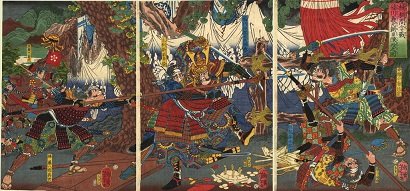
Nobunaga had an army of only three thousand men, to his opponent’s 25,000. To even stand a chance, he had to use cunning. He first led his army to a temple in Yoshimoto’s path, as if to block his advance. Then, leaving their banners behind, his forces sneaked into the forest and circled round to the rear of the Imagawa army. The army had halted due to the oppressive heat, and the warriors were celebrating their recent string of victories. A sudden thunderstorm gave Nobunaga the cover he needed, and his men were able to get into position unseen. When the storm passed he launched a surprise attack, throwing the Imagawa forces into complete disarray. The Oda warriors made directly for the commander’s tent, where Yoshimoto made things easy for them by stepping out to yell at his men to keep the noise down. By the time he realised it was the sounds of battle and not celebration that he heard, it was too late. A pair of Oda soldiers fell upon him and beheaded him.
The Battle of Okehazama, as it became known, transformed Nobunaga into a true power in the land overnight. To have defeated a force so much larger than his own was a legendary feat, but in addition the casualties among the Imagawa forces came almost exclusively from their leadership. Left adrift, they turned to the man who had defeated them. Nobunaga found himself in charge of an army nearly ten times the size of his original forces, and was able to use this strength to secure marriage alliances that consolidated his position. It was also at this time that he gained the two loyal lieutenants who would become legends in their own right. The first was Matsudaira Motoyasu, who would later change his name to Tokugawa Ieyasu. Ieyasu had been forced to ally his clan to the Imagawa through having his wife and child taken hostage, but with Nobunaga’s help he was able to free them. The second was a peasant named Kinoshita who was a servant in his army. Though of humble birth his talent was reportedly self evident, and Nobunaga was quick to take advantage of it.

Kinoshita’s diplomatic talents were put to work against the Saito clan of Mino province, and he soon managed to persuade a great deal of their retainers to defect to the Oda ranks. Nobunaga, of course, had been named as heir to the Saito leadership by his father-in-law several years before, and so none could deny him the right to try to assert his claim. Over the course of the 1560s he took the Saito lands piece by piece, and by 1566 he was almost ready to make his final move. He ordered Kinoshita to construct a castle near the Saito capital at Inabayama, to serve as a rallying point. By cunningly making the castle appear completed long before it actually was, Kinoshita managed to prevent the enemy from attacking until it was too late. For this feat Nobunaga gave him the new name “Hideyoshi”, meaning “excellent good fortune”. [3] In the final attack on Inabayama, on the night of 26th September 1567, Hideyoshi led a small strike force to scale the mountain behind the castle. At dawn the next morning they infiltrated the fortress, set a fire that detonated a gunpowder storehouse, and opened the gates for the main force. So overwhelming was Nobunaga’s victory that, like the Imagawa before them, the clans of Mino province soon swore fealty to the Oda.
In 1568 Nobunaga became drawn into the deadly games of the Shogunate. Four years earlier Ashikaga Yoshiteru, the puppet shogun Yoshimoto had hoped to supplant, had attempted to assert his authority and become the ruler in truth. With no real power, his diplomatic skill was still formidable enough to see him begin to amass an independent power base. However this was resented by those at court who saw a shogun as someone to control, not someone to be controlled by. They attacked the young shogun’s dwelling, planning to depose him and install a relative of his as shogun. Yoshiteru slew himself rather than suffer this indignity. Three years later, after much vicious infighting, the winning faction of ambitious courtiers managed to install his cousin Yoshihide as shogun. The other alternative heir, Yoshimoto’s brother Yoshiaki, fled the capital and sought sanctuary in Gifu. (This was the new name Nobunaga had given Inabayama after he conquered it.) Nobunaga gathered his forces and marched on Kyoto with the intention of deposing Yoshihide. He failed to do this, but only because Yoshihide died of disease while he was enroute. Nobunaga installed Yoshiaki in the shogunate, and became (as the man behind the throne) the most powerful warlord in the country.
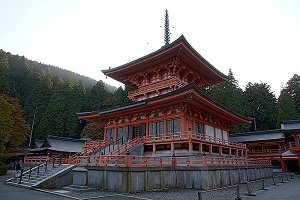
Over the next few years Nobunaga’s fame continued to grow, though his reputation had a dark tinge. In 1570 he fought against an alliance between his old overlords the Asakura and their allies the Azai (including his brother-in-law Azai Nagamasa). He defeated the alliance, but the most notable incident came afterwards. The monks of the Enryaku-ji monastery, who hired themselves out as mercenaries, had fought for the Azai-Asakura forces. In retaliation Nobunaga attacked the monastery, massacring even the non-combatant inhabitants and sending his men out into the countryside to hunt and kill any who had escaped. A similar slaughter of civilians occurred in 1574. The previous year Nobunaga had decided he did not need the shogun any more, and had forced Ashikaga Yoshiaki to take holy orders before driving him out of the capital. Yoshiaki had turned to the Ikko-ikki, a working-class anarchist/Buddhist sect who were fighting a guerrilla war against the samurai upper class. Nobunaga fought a bitter war against them. Two of his brothers died, but in retribution he burned their fortress at Nagashima allowing nobody to escape. The entire population, including over ten thousand women and children, died in the blaze.

By 1582 Nobunaga was the undisputed premier warlord of Japan, and was well on his way to consolidating the entire country under his rule. In June of that year Hideyoshi was leading an army to crush one of the few clans that still opposed his master, while Ieyasu was off bringing the territory that had belonged to a recently defeated clan under his control. Nobunaga himself was journeying from Ieyasu’s army to join Hideyoshi’s forces, and stopped off in Kyoto on the way. As was his habit he stayed at the Honno-ji Temple, along with a small force of retainers. Travelling the same route was Akechi Mitsuhide, a lord who had served as Yoshiaki’s bodyguard and had been the one to suggest to him that he appeal to Nobunaga. Unfortunately for Nobunaga, Mitsuhide had decided to rebel against him. Many reasons are suggested for why he might have done this. Some point to a resentment of how Nobunaga had treated Yoshiaki. Some say that there were rumours Nobunaga planned to confiscate Mitsuhide’s land and give it to one of his favourites. It’s also suggested that Mitsuhide’s aunt had been murdered in retaliation for an oath Nobunaga had broken, and Mitsuhide blamed him for her death. It may even have been as simple as Nobunaga having insulted Mitsuhide publicly. Whatever the reason, Mitsuhide led a force of thirteen thousand men to the temple. They surrounded it and set it ablaze. (Though some accounts have it that Nobunaga set it ablaze in order to prevent them being able to capture him.) With no way to escape, Nobunaga was either killed resisting capture, or committed suicide. He was 58 years old.
Following the battle Mitsuhide’s forces also managed to kill Nobunaga’s designated heir, his son Nobutada. Though Mitsuhide then tried to take command of Nobunaga’s forces, it was Hideyoshi who was able to seize the reins of power. He managed to get his army back to the capital in only four days, blindsiding Mitsuhide, and defeated him in a swift and decisive battle. Mitsuhide fled and was never heard from again. [4] Hideyoshi had the Emperor name him officially as Regent and managed to unite Japan under his rule, though he failed in a later campaign to invade Korea. He died in 1598, leaving his five year old son Hideyori as his heir. The child was brushed aside by Tokugawa Ieyasu, Nobunga’s other lieutenant. In 1600 Ieyasu took the title of Shogun, beginning a ruling dynasty that would control Japan until the late 19th century. This result is expressed in an old Japanese proverb describing the period, which loosely translates as:
Nobunaga makes the cake, Hideyoshi bakes the cake, but Ieyasu eats it.
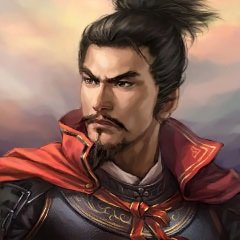
Nobunaga is, of course, a major figure in Japanese history. His rise to power is regarded as the first act of the Sengoku period in Japanese history, as this struggle for ascendancy came to be known. Many books have been written about this time, and Nobunaga’s role has been considered from many angles. Some have him as a benevolent ruler, but most remember his ruthlessness (and regard his lack of respect for tradition as dangerous), and so more often than not he has been portrayed as evil, even demonic. Nowadays he is best known outside of Japan for his role in video games set in the period, ranging from historical recreations all the way to fantasy games like Onimusha which have him as a literal demon king. Yet throughout all of these portrayals, two things remain constant. This first is the ambition, overwhelming and undeniable, that drove him. And the second is the consensus that, regardless of what people had thought of him as a child, Nobunaga was nobody’s fool.
Images via wikimedia except where stated.
[1] For readability purposes I’ll be mostly using the English equivalent of Japanese titles and honorifics throughout, with some exceptions for terms with no direct translation.
[2] Dosan’s son rebelled against him, and Nobunaga arrived to late to prevent patricide. Dosan’s final act in naming Nobunaga as his heir to spite his son would later give Nobunaga a casus belli to defeat and absorb the Saito clan.
[3] Or, for a more colloquial translation, “jammy git”.
[4] Though he was probably killed fleeing the battle, one legend of the monk Tenkai (who was adviser to three later generations of shoguns) was that he was actually Mitsuhide doing penance for his betrayal.

Great read! Any good books you could recommend on this?
War in Japan, 1467-1615 by Stephen Turnbull is a good history of the whole Sengoku period and you can get it on Kindle or in paperback on Amazon. There’s also a three-volume history of Japan by George Sansom, volume 2 would cover the period in question. It’s pretty good but it’s only available in physical form (and is a bit pricier).